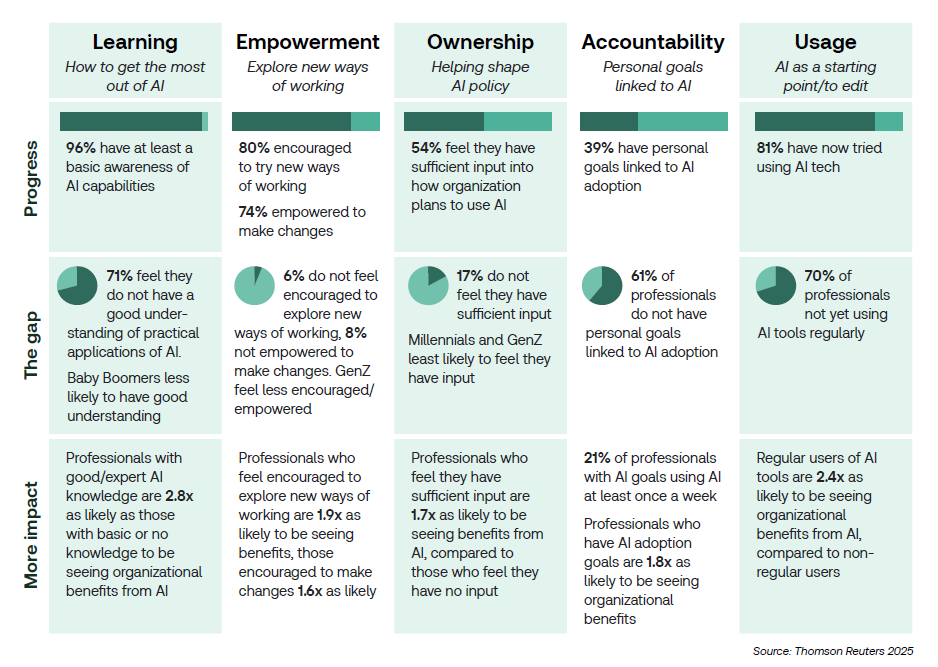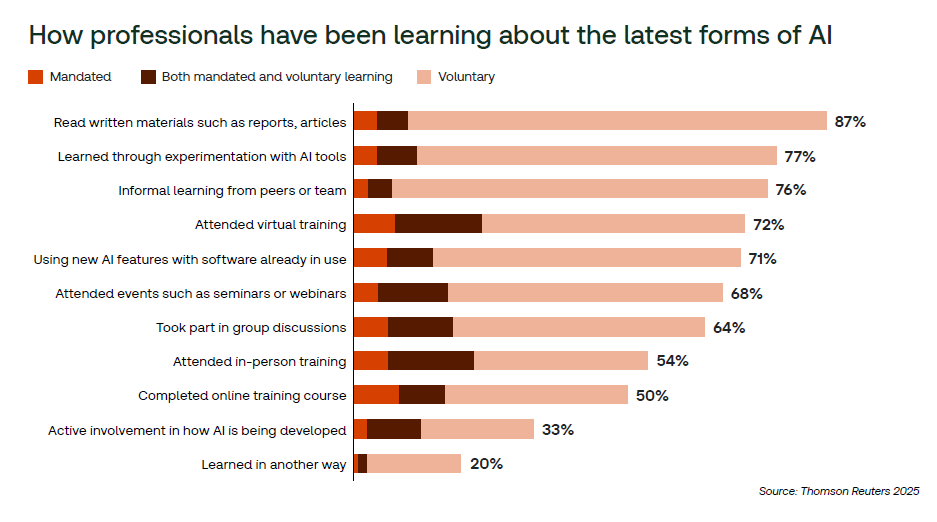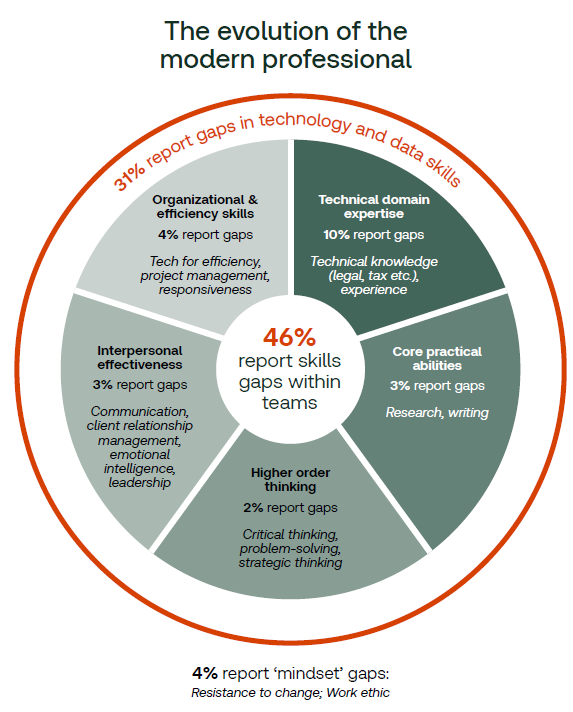According to new research, organization leaders need to take an active role in developing an AI strategy to convert awareness into understanding — and map that strategy to the skills their teams need to grow
Key findings:
-
-
There’s a gap between AI awareness and understanding — The recent 2025 Future of Professionals Report shows that while 96% of professionals have at least a basic awareness of AI, 71% lack a strong understanding of its practical applications. This gap limits professional services organizations from truly maximizing their investment in AI tools.
-
AI strategy drives both professional development and ROI — Professionals with good or expert AI knowledge were found to be 2.8-times as likely to see organizational benefits from AI when compared to those with lesser knowledge. Similarly, companies and firms with a visible, top-down AI strategy are 3.5-times as likely to see positive returns on investment from AI. Both show a clear benefit to aligning skills training and overall organization AI strategy.
-
Identifying and addressing AI-related skills gaps is essential — Nearly half of professionals said they see skills gaps within their teams, including both technical and soft skills needed for successful AI adoption. Leaders who identify these gaps and tailor AI training to specific team needs will maximize the benefits of AI in the workplace.
-
In the nearly three years since ChatGPT introduced generative AI (GenAI) to a wide public audience, AI applications have increasingly been making their way into business tools and workflows. Whether AI, GenAI, or (increasingly) agentic AI, professionals in the legal, tax & accounting, and government industries have been introduced to new AI concepts at a dizzying speed.
As many professionals try to keep up, they are understandably having trouble staying ahead of the pace of change. According to results from the recent Thomson Reuters 2025 Future of Professionals Report, which examines the trends impacting professionals careers, most professionals at this point know what AI can do. Where they’re struggling, however, is making the next step in determining how those use cases apply to them. This leap is even more pronounced with more senior members of many organizations, the report shows.
Although many professionals now have access to these next-generation tools, it’s clear that despite their best efforts, some don’t quite know how to apply AI, GenAI, and other related technologies to the best of their ability and for maximum advantage. For senior leaders of organizations, this means a change in approach is needed — and that may mean crafting an overarching AI strategy that allows professionals to achieve real goals that will also help the organization at large.
A gap between awareness and understanding
The idea that professional services organizations are behind the times with regards to technology may be an antiquated concept. Law firms of all sizes, for instance, have continued to invest in technology at a rate above inflation for the past decade, according to the Thomson Reuters Institute’s Law Firm Financial Index. Studies in tax & accounting and government have yielded similar results. Further, the interest in GenAI has amplified, with many large organizations adopting GenAI technologies, and even beginning to build their own proprietary systems.
With this in mind, it’s not surprising that the Future of Professionals Report found that 96% of surveyed professionals said they have some basic awareness of AI capabilities. AI has been baked into the systems that underpin daily work product and back-office functions at a rapid pace.
However, when asked whether they have an understanding of AI’s practical applications, rather than simply awareness, many professionals begin to falter. In fact, 71% said they feel they do not have a good understanding of the practical applications of AI to their own careers. This percentage is even higher for the Baby Boomers, who due to seniority are more likely to hold positions of leadership.

There are a number of reasons why this gap can have occurred, according to the research. For one, less than half (39%) of all professionals say they have personal goals linked to AI adoption, creating less of an impetus to actually setting aside precious time to discover the practical applications of these tools. Some professionals also reported that they do not feel like they have input into AI policy, or do not feel encouraged to explore new ways of working, particularly at more junior levels.
The business implications of this are clear. The research found that knowledge of AI’s applications has a direct correlation with receiving benefits from AI’s use in the organization, as professionals with good or expert AI knowledge were found to be 2.8-times as likely to see organizational benefits from AI when compared to those with lesser knowledge.
The evolution of the modern professional
Given the rapid rate of AI adoption, it’s no surprise that corporations and firms alike are increasingly looking to develop more business strategy around AI usage. And indeed, the Future of Professionals research indicates that organizations with a visible AI strategy are 3.5-times as likely to be experiencing at least one form of positive return on investment from overall AI usage.
So, how does that top-down strategy filter down to legal, tax & accounting, and government professionals themselves? According to the research, the discrepancy between AI awareness and AI understanding is not a matter of desire. Professionals want to be upskilled in this area. In fact, more than three-quarters of professionals said they are voluntarily reading reports and articles about AI in their industry, and more than two-thirds have said they’ve voluntarily experimented with AI tools or held informal learning sessions with their colleagues.

Yet, the difference between awareness and understanding remains, even with these increased opportunities for learning. According to the research, however, it’s not one way of learning alone that lends itself best to closing this gap. Instead, the biggest predictor of AI proficiency is engaging in a wide variety of learning methods, both on an organizational and personal level. Put another way, it’s a plan for comprehensive training and education, rather than simply a single training session or a module.
This clearly indicates that organization leaders need to take an active role in developing a more comprehensive strategy to convert awareness into understanding — and map AI understanding to what skills their teams need to grow.

Almost half of professionals reported skills gaps within their teams that are need to be addressed before the team can become a fully actualized contributor to the organization. In many cases, these skills gaps may be technology or data skills and could include the ability to use technologies such as GenAI. In other cases, however, there may be gaps in more soft skills, areas that touch technology but are not inherently technical — such as organizational and efficiency skills, interpersonal effectiveness, and higher-order thinking.
Closing the gap between AI awareness and AI understanding will not be the same for every person and every team. The most effective leaders will be the ones who take the time to identify where those gaps exist and determine the specific use cases in which AI can be leveraged to aid those deficiencies. As the 2025 Future of Professionals Report shows, however, taking this time can yield tangible results — both in getting the most out of these new technologies and helping professionals reach their true potential in an AI-enabled future.
You can download a copy of Thomson Reuters Future of Professionals 2025 here







